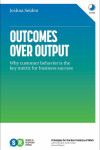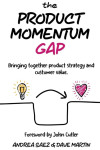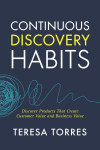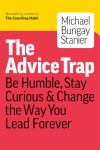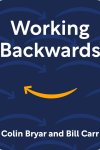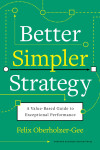The Product Momentum Gap
Bringing together product strategy and customer value
"The Product Momentum Gap" addresses the critical inflection point where successful startups struggle to maintain product velocity during scaling. The book identifies the predictable moment when founder-led teams transition to distributed product decision making, often resulting in stalled growth despite increased resources.
The authors introduce the Product Value Creation Plan (VCP) as a framework for maintaining customer focus while scaling organizational complexity. Unlike traditional product strategy approaches that focus on market positioning and business models, the VCP centers on understanding specific customer behaviors that create value. This behavioral focus provides teams with actionable direction for distributed decision making.
Written for founders, first-time scaling leaders, product leaders, and executives navigating their initial growth journey, the book offers practical tools for creating alignment and avoiding expensive scaling mistakes. Rather than prescriptive methodologies, it provides frameworks that adapt to different organizational contexts while maintaining focus on customer value creation.
By reading The Product Momentum Gap, you will:
- Master the transition from founder-led to team-led product development: Learn why scaling product teams often lose momentum and how to maintain customer empathy while building systematic product management practices that replace founder intuition.
- Build a Product Value Creation Plan that drives alignment: Create clear connections between customer behaviors, product features, and business outcomes that enable distributed decision making and reduce reactive feature requests.
- Identify and bridge the momentum gap before it derails growth: Recognize the warning signs of scaling dysfunction and implement frameworks for maintaining product velocity while adding team members and organizational complexity.
- Transform product strategy into actionable team guidance: Move beyond high-level vision statements to behavior-focused direction that helps teams understand not just what to build but which customer actions will create sustainable value.
- "Good Strategy Bad Strategy" by Richard Rumelt: Provides complementary strategic thinking frameworks emphasizing diagnosis before action. While "The Product Momentum Gap" focuses on customer behavior identification, Rumelt's work helps leaders develop coherent action plans and avoid common strategic planning mistakes that plague scaling product teams.
- "Outcomes Over Output" by Josh Seiden: Builds on the VCP framework by providing methods for measuring customer outcomes rather than feature delivery. Seiden's approach to outcome-focused product management aligns with the behavioral focus of the Product VCP, showing how to track progress toward customer value creation.
- "Escaping the Build Trap" by Melissa Perri: Addresses organizational dysfunction that creates the product momentum gap. Perri's focus on product culture and decision making processes complements the VCP framework by showing how to create organizational structures that support customer-centered product development.
- "Continuous Discovery Habits" by Teresa Torres: Provides systematic approaches for maintaining customer contact and insight generation that support VCP development. Torres shows how product teams can build ongoing customer empathy while scaling, addressing one of the key challenges identified in the momentum gap.
- "Team Topologies" by Matthew Skelton and Manuel Pais: Explains how to structure teams for fast flow of change. Complements the VCP by showing organizational patterns that enable distributed decision making and reduce coordination friction during scaling.
- "Working Backwards" by Colin Bryar and Bill Carr: Shares Amazon’s mechanisms for scaling customer obsession. Reinforces the book’s central message that customer value creation comes before revenue capture, and offers concrete practices like PR/FAQ that connect well with the VCP.
- "Empowered" by Marty Cagan: Shows how leaders can create empowered product teams that take responsibility for outcomes. Strengthens the VCP’s emphasis on distributed decision making by illustrating leadership practices that enable autonomy and alignment at scale.
The Momentum Gap is Predictable and Addressable
Scaling product organizations consistently hit inflection points where growth stalls despite increased resources. This happens because founder intuition does not scale with team size and traditional product management practices often focus on features rather than customer value creation. Understanding this pattern helps leaders prepare for and navigate the transition more effectively.
Customer Behavior Focus Drives Alignment
Product strategy typically covers market positioning and business goals but fails to provide actionable guidance for daily decisions. The Product Value Creation Plan centers on specific customer behaviors that generate value, giving teams clear direction for feature prioritization and decision making. This behavioral focus connects product work directly to customer outcomes.
Value Creation Precedes Value Capture
Teams often focus on business metrics like revenue growth rather than understanding how customers actually derive value from products. Real customer value occurs when users develop repeatable behaviors that create positive impact in their lives or work. Product teams must understand and optimize these behaviors before expecting business results.
Discovery Investment Prevents Feature Waste
Research commonly cited in the book shows that around 80% of released features are rarely or never used, indicating massive waste in traditional feature-focused development. Investing in customer discovery and behavior validation before building prevents this waste while enabling teams to focus on initiatives that actually drive customer adoption and value creation.
Distributed Decision Making Requires Shared Understanding
As organizations grow, decision concentration with founders limits scaling potential. Effective distributed decision making requires shared frameworks for understanding customer value, not just shared goals or visions. Teams need common language and tools for evaluating opportunities and making consistent choices aligned with customer needs.
Experimentation Mindset Reduces Risk
Traditional business culture treats mistakes as failures, but product development requires experimentation to discover what creates customer value. Teams must develop comfort with being wrong about initial assumptions while building systematic approaches to testing and learning from customer behavior data.
Alignment Beats Individual Excellence
Small numbers of misaligned team members can erode organizational focus regardless of their individual skills. Product scaling success depends more on shared understanding and direction than on hiring exceptional individual contributors. Investment in alignment mechanisms often produces better results than talent acquisition alone.
Q: How does the Product VCP differ from traditional product strategy?
A: Traditional product strategy focuses on market analysis, competitive positioning, and business model design, essentially the “what” and “why” of product development. The VCP focuses specifically on customer behaviors and actions that create value, the “how” that connects strategy to daily execution. While strategy provides direction, the VCP provides actionable guidance for feature decisions and prioritization.
Q: Why do founder-led companies struggle when scaling product teams?
A: Founders initially succeed through direct customer empathy and rapid decision making based on personal understanding of customer problems. As target audiences broaden and teams grow, founders cannot maintain direct contact with all customer segments or make every product decision. Their original customer empathy does not scale, while teams lack systematic methods for developing customer understanding.
Q: What causes the 80% feature abandonment rate mentioned in the book?
A: Teams build features based on assumptions about customer needs rather than validated understanding of customer behaviors. Without clear connection between features and specific customer value creating actions, most features address problems customers do not actually have or solve them in ways customers do not adopt. Discovery investment before building prevents this waste.
Q: How can product teams maintain speed while investing in discovery?
A: Parallel discovery and delivery approaches allow discovery and implementation to happen at the same time rather than in long sequential phases. While one team validates customer problems and solutions, another delivers previously validated work. This maintains shipping velocity while ensuring future development focuses on features customers will actually use and value.
Q: What is the difference between product outcomes and business outcomes?
A: Business outcomes like revenue growth or market share result from multiple business functions including sales, marketing, customer success, and product. Product outcomes focus on customer behaviors directly influenced by product features such as adoption rates, usage patterns, and customer satisfaction. Product teams should optimize for product outcomes that enable business outcomes rather than trying to directly control business metrics.
Q: How do you know if your VCP is working effectively?
A: Effective VCPs produce measurable changes in customer behavior that correlate with business results. Teams can make consistent decisions about feature priorities without escalation to leadership. Customer feedback becomes more predictable because teams understand which behaviors create value. Business stakeholders see clear connection between product investment and customer outcomes, and teams experience greater autonomy.
Q: When should founders step back from product decisions?
A: Founders should begin transitioning when they become the bottleneck for product decisions or when they lack direct contact with expanding customer segments. However, stepping back requires establishing systems for customer empathy and decision making frameworks first. Abrupt founder withdrawal without systematic replacement often accelerates momentum gap problems.
Q: How does the momentum gap affect different company sizes?
A: Early-stage companies with fewer than 50 people rarely experience true momentum gaps because founders can maintain direct involvement. The gap typically emerges between 50 and 200 employees when product decisions must be distributed but systematic customer understanding has not replaced founder intuition. Companies with more than 200 people either have solved the gap or are struggling with significant alignment and velocity issues. These ranges are indicative rather than strict thresholds.
- When transitioning from founder-led to distributed product decisions: Your startup has achieved initial success and needs to scale beyond the founder’s direct involvement. The book helps establish frameworks for maintaining customer focus while building systematic product management practices that replace founder intuition.
- During rapid team scaling with stagnating product velocity: You are adding people but shipping speed and impact are not increasing proportionally. The book diagnoses common scaling bottlenecks and provides the VCP framework for maintaining alignment and decision making clarity across larger teams.
- When product strategy feels disconnected from daily execution: Your product vision and strategic documents exist but teams struggle to make consistent decisions or prioritize effectively. The book bridges the gap between high-level strategy and actionable team guidance through behavior-focused planning.
- While experiencing investor pressure despite resource increases: Board members or stakeholders question why increased investment is not producing expected growth results. The book helps identify and address the underlying misalignment between product development activities and actual customer value creation.

Your support helps me maintain and improve the book recommendations for everyone.
